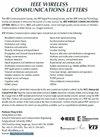基于载波图像的数字信号语义通信
IF 5.5
3区 计算机科学
Q1 COMPUTER SCIENCE, INFORMATION SYSTEMS
引用次数: 0
摘要
目前大多数语义通信(SemCom)框架都侧重于图像传输,而没有解决如何在没有任何语义特征的情况下传输数字信号的问题。本文提出了一种利用图像作为载波信号来传输数字信号的SemCom方法。具体来说,该方法将数字信号编码为二进制流,并将其映射到图像上的掩码位置。这使得二进制数据可以可视化地表示,从而可以使用现有的模型,预训练的掩码自动编码器(MAE)作为SemCom编码器和解码器,该模型针对掩码图像重建进行了优化。由于MAE可以处理和恢复被屏蔽的图像,这种方法允许数字信号和图像的联合传输,而不会产生显著的通信开销。此外,考虑到由MAE编码的掩码令牌传输仍然面临额外的成本,我们在发送端设计了一个稀疏编码模块,将掩码令牌编码成稀疏矩阵,并在接收端进行恢复。因此,该方法只需要传输未掩码补丁的潜在表示和稀疏矩阵,与原始MAE编码器相比,进一步降低了传输开销。仿真结果表明,即使在高掩码比的情况下,该方法仍能保持可靠的传输。本文章由计算机程序翻译,如有差异,请以英文原文为准。
Semantic Communications for Digital Signals via Carrier Images
Most of current semantic communication (SemCom) frameworks focus on the image transmission, which, however, do not address the problem on how to deliver digital signals without any semantic features. This letter proposes a novel SemCom approach to transmit digital signals by using the image as the carrier signal. Specifically, the proposed approach encodes the digital signal as a binary stream and maps it to mask locations on an image. This allows binary data to be visually represented, enabling the use of existing model, pre-trained Masked Autoencoders (MAE), which are optimized for masked image reconstruction, as the SemCom encoder and decoder. Since MAE can both process and recover masked images, this approach allows for the joint transmission of digital signals and images without incurring significant communication overheads. In addition, considering the mask tokens transmission encoded by the MAE still faces extra costs, we design a sparse encoding module at the transmitter to encode the mask tokens into a sparse matrix, and it can be recovered at the receiver. Thus, this approach simply needs to transmit the latent representations of the unmasked patches and a sparse matrix, which further reduce the transmission overhead compared with the original MAE encoder. Simulation results show that the approach maintains reliable transmission even in a high mask ratio of images.
求助全文
通过发布文献求助,成功后即可免费获取论文全文。
去求助
来源期刊

IEEE Wireless Communications Letters
Engineering-Electrical and Electronic Engineering
CiteScore
12.30
自引率
6.30%
发文量
481
期刊介绍:
IEEE Wireless Communications Letters publishes short papers in a rapid publication cycle on advances in the state-of-the-art of wireless communications. Both theoretical contributions (including new techniques, concepts, and analyses) and practical contributions (including system experiments and prototypes, and new applications) are encouraged. This journal focuses on the physical layer and the link layer of wireless communication systems.
 求助内容:
求助内容: 应助结果提醒方式:
应助结果提醒方式:


